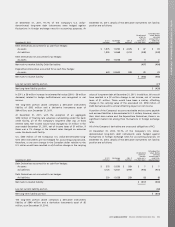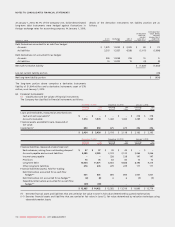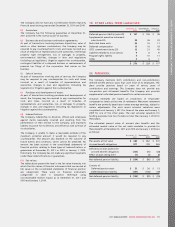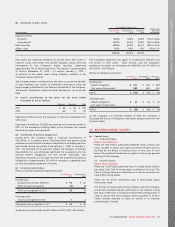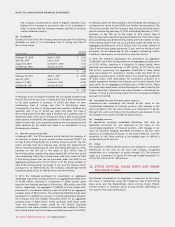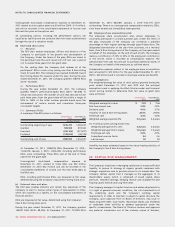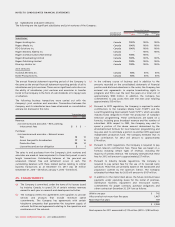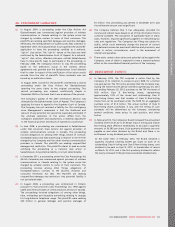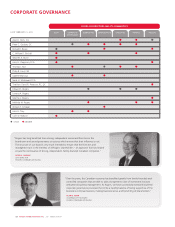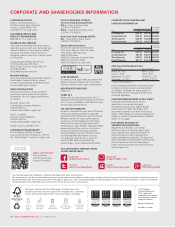Rogers 2011 Annual Report Download - page 129
Download and view the complete annual report
Please find page 129 of the 2011 Rogers annual report below. You can navigate through the pages in the report by either clicking on the pages listed below, or by using the keyword search tool below to find specific information within the annual report.
NOTES TO CONSOLIDATED FINANCIAL STATEMENTS
26. CONTINGENT LIABILITIES:
(a) In August 2004, a proceeding under the Class Actions Act
(Saskatchewan) was commenced against providers of wireless
communications in Canada relating to the system access fee
charged by wireless carriers to some of their customers. The
plaintiffs are seeking specified damages and punitive damages,
effectively, the reimbursement of system access fees collected. In
September 2007, the Saskatchewan Court granted the plaintiffs’
application to have the proceeding certified as a national,
“opt-in” class action. The “opt-in” nature of the class was later
confirmed by the Saskatchewan Court of Appeal. As a national,
“opt-in” class action, affected customers outside Saskatchewan
have to take specific steps to participate in the proceeding. In
February 2008, the Company’s motion to stay the proceeding
based on the arbitration clause in the wireless service
agreements was granted and the Saskatchewan Court directed
that its order in respect of the certification of the action would
exclude from the class of plaintiffs those customers who are
bound by an arbitration clause.
In August 2009, counsel for the plaintiffs commenced a second
proceeding under the Class Actions Act (Saskatchewan)
asserting the same claims as the original proceeding. This
second proceeding was ordered conditionally stayed in
December 2009 on the basis that it was an abuse of the process.
The Company’s appeal of the 2007 certification decision was
dismissed by the Saskatchewan Court of Appeal. The Company is
applying for leave to appeal to the Supreme Court of Canada.
The Company has not recorded a liability for this contingency
since Management’s assessment is that the likelihood and
amount of any potential loss cannot be reasonably estimated. If
the ultimate resolution of this action differs from the
Company’s assessment and assumptions, a material adjustment
to the financial position and results of operations could result.
(b) In June 2008, a proceeding was commenced in Saskatchewan
under that province’s Class Actions Act against providers of
wireless communications services in Canada. The proceeding
involves allegations of, among other things, breach of contract,
misrepresentation and false advertising in relation to the 911 fee
charged by the Company and the other wireless communication
providers in Canada. The plaintiffs are seeking unquantified
damages and restitution. The plaintiffs intend to seek an order
certifying the proceeding as a national class action in
Saskatchewan. Any potential liability is not yet determinable.
(c) In December 2011, a proceeding under the Class Proceedings Act
(British Columbia) was commenced against providers of wireless
communications in Canada relating to the system access fee
charged by wireless carriers to some of their customers. The
proceeding involves among other things, allegations of
misrepresentations contrary to the Business Practices and
Consumer Protection Act (BC). The Plaintiffs are seeking
unquantified damages and restitution. Any potential liability is
not yet determinable.
(d) In August 2008, a proceeding was commenced in Ontario
pursuant to that province’s Class Proceedings Act, 1992 against
Cable and other providers of communications services in Canada.
The proceedings involved allegations of, among other things,
false, misleading and deceptive advertising relating to charges
for long-distance telephone usage. The plaintiffs were seeking
$20 million in general damages and punitive damages of
$5 million. This proceeding was settled in December 2011 and
the settlement amount was insignificant.
(e) The Company believes that it has adequately provided for
income and indirect taxes based on all of the information that is
currently available. The calculation of applicable taxes in many
cases, however, requires significant judgment in interpreting tax
rules and regulations. The Company’s tax filings are subject to
audits, which could materially change the amount of current
and deferred income tax assets and liabilities and provisions, and
could, in certain circumstances, result in the assessment of
interest and penalties.
(f) There exists certain other claims and potential claims against the
Company, none of which is expected to have a material adverse
effect on the consolidated financial position of the Company.
27. SUBSEQUENT EVENTS:
(a) In February 2012, the TSX accepted a notice filed by the
Company of its intention to renew its prior NCIB for a further
one-year period. The TSX notice provides that the Company may,
during the twelve-month period commencing February 24, 2012
and ending February 23, 2013, purchase on the TSX the lesser of
36.8 million Class B Non-Voting shares, representing
approximately 10% of the issued and outstanding Class B
Non-Voting shares, and that number of Class B Non-Voting
shares that can be purchased under the NCIB for an aggregate
purchase price of $1.0 billion. The actual number of Class B
Non-Voting shares purchased, if any, and the timing of such
purchases will be determined by the Company considering
market conditions, share prices, its cash position, and other
factors.
(b) In February 2012, the Company’s Board increased the annualized
dividend rate from $1.42 to $1.58 per Class A Voting and Class B
Non-Voting share effective immediately to be paid in quarterly
amounts of $0.395 per share. Such quarterly dividends are only
payable as and when declared by the Board and there is no
entitlement to any dividends prior thereto.
At the same time, in February 2012, the Board declared a
quarterly dividend totalling $0.395 per share on each of its
outstanding Class A Voting and Class B Non-Voting shares, such
dividend to be paid on April 2, 2012, to shareholders of record
on March 19, 2012, and is the first quarterly dividend to reflect
the newly increased $1.58 per share annualized dividend rate.
2011 ANNUAL REPORT ROGERS COMMUNICATIONS INC. 125


